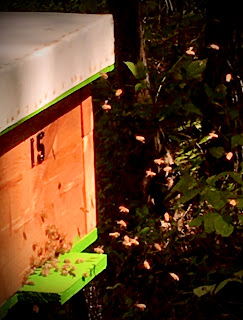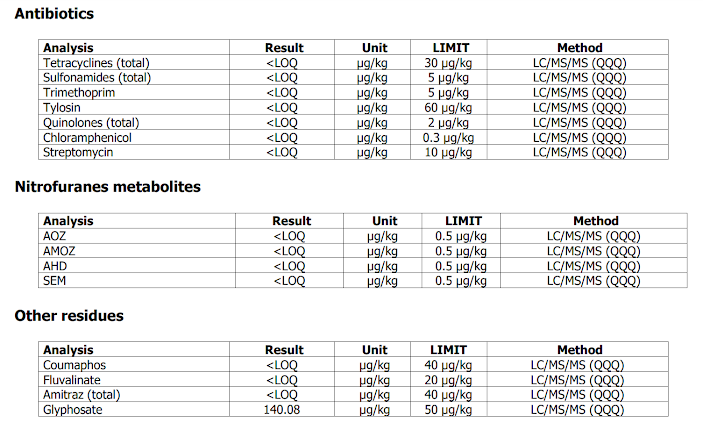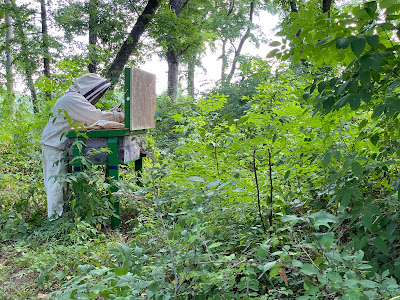It’s been almost four months since our last blog post. As I write this journal entry, I am sitting beside a beautiful lake at the campus of the American University of Iraq - Baghdad, where I have been working for the past year. Between my work in Iraq and the restrictions imposed on everyone around the world by COVID-19, I was not able to visit Irish Acres Apiary for a full year - twelve full months without a single hive inspection, without opening the hives, without any treatments or feeding, nothing. For one full year, our colonies of bees were on their own, left to their devices, without any “beekeeping” help from humans. How did they do?
Well, as it turns out, they did pretty well!
When I left Kentucky for Iraq in early October, 2019, I left behind eight hives, a number that was down from the previous year as I had been in Iraqi Kurdistan for the previous year and was unable to visit the apiary regularly, catch swarms, split hives, and do all the work that a good beekeeper does to grow the apiary and replace colonies that inevitably die every year or do not survive the winter. Still, these eight were in various stages of strength; most were strong and solid and I fully expected them to survive the winter, while others were weak with the chances of their survival depending on the vagaries of winter and how bad the weather would be during the colder months. Of these eight hives, two were Layens hives and the other six were Horizontal hives. My expectation, though, was that most or all would make it through the winter and then in the spring I would visit them, make some splits, maybe add a few purchased nucs from a treatment-free apiary, and have a very productive year. Instead, I have no idea how many colonies managed to survive the winter while any colonies that swarmed were lost to the surrounding countryside (not a bad thing in itself as we can always use more bees in the wild!), and I was not able to add to the apiary through splits or purchased nucleus hives.
COVID-19 prevented any of that from happening, however. Since coronavirus hit in early February, Iraq was locked down and it was not possible to travel outside the country until later in the summer, at which point it was too late to manage swarms, start hives, or do splits. Subsequent visa and residency issues in Iraq prevented travel at that point, so it was not until the middle of October that I was finally able to leave the country and go home for the first time in a year.
Arriving at my farm on a beautiful fall day, the temperature was in the 60s so it was a good time to visit the apiary and open the hives. First, I did an “entrance inspection,” which showed that four hives were very active with lots of coming and going as the worker bees continued carrying in supplies and preparing the hive for winter. This meant that after one full year of zero “management” from the beekeeper, half the hives survived and in fact looked to be quite strong. Now it was time to break out the bee suit and tools and inspect each hive.
What I found was surprising! First, the two Layens hives were dead. One of these was weak when I last saw it and I did not expect it to make it through the winter, and it probably did not. The second one, however, was very strong when I left it, but it had zero entrance activity now. When I opened it, my heart sank - it was absolutely full of wax moths and not a bee in sight. What I found, though, was instructive. All Layens frames were fully built out and had surely been loaded with honey by the time winter hit in 2019. I checked my records and it was very strong and on its way to having all frames built with comb with plenty of honey when I checked it last October. It surely survived the winter, but sometime this year, the colony absconded or died off. One possible scenario is that it came out of the winter very strong in early 2020 and proceeded to cast off several swarms until the remaining colony was too weak to survive and absconded due to mites or wax moths. At this point, I could not tell because the moth infestation was so strong and the combs were mostly destroyed. I cleaned out thousands of larvae, but had to leave many more behind, so I just sealed the hive up and left it to the moths until next spring when I will clean it out and hopefully install a caught swarm in it. The other Layens hive was also dead with the same result.
Once a colony absconds, two things usually happen - other bees rob it of all its honey stores and wax moths move in to eat all the wax. In nature, this latter phase is a natural part of the beehive cycle as the moths perform a useful function of cleaning out a tree hollow of its old wax so a new colony can move into a clean space and build fresh comb. By the time I reopen this hive in the spring of 2021, the moths will have died off due to lack of food and the cold and I will clean out the hive and start over with a new colony.
The only hives that survived were the Horizontal Hives made of cedar and those four did splendidly! On opening them up, three of the four were stuffed with bees and comb was built out to the last frame - 32 frames in each one. Even the last frame was built out with honey and bees on it and checking frames closer into the brood nest area showed that the hive was heavily populated and well prepared for winter. I did not harvest any honey from these four, but left it all for the bees as I want these four hives to get through the winter and then in the spring I will make splits from them to repopulate the apiary. These four colonies are obviously very strong with great genetics so they should split very well and produce strong and vigorous daughter colonies.
The weakest of these four hives was still in pretty good shape. It had about 17 frames filled out with comb and honey, plenty of bees, so it too should over-winter and be ready to split in the spring. With any luck, swarm traps will also catch some swarms in April and May, some of which may well be from the bees that swarmed in the spring of 2020. All in all, I feel very good that 2021 is going to be a great year for Irish Acres Apiary and we will see tremendous growth in the number of colonies, with all that growth coming from strong, proven genetics that can survive treatment-free.
So what does all this tell us? First, it shows that treatment-free works! If all these hives had been the conventional vertical hives with thin walls sold in hardware stores, with bees that are treated heavily for mites, fed sugar, given antibiotics, and “managed” by the beekeeper opening them up every week or two, it is highly doubtful that they would have managed on their own so well and gotten through the winter. Not only did these four hives survive, but they flourished during 2020 and built themselves up to very strong levels.
Second, it proves the wisdom of using hives that mimic natural beehives in the forest - thick walls, good insulation, spread out so bees don’t drift between hives spreading disease and mites, and giving them plenty of room to design their hive interior as they wish.
Third, it makes sense to allow nature and its Darwinian processes to select the best bees for survival in your local conditions. Nature always knows best, the bees know how to manage their lives without us, and they will make the best decisions needed for colony survival. Did my other colonies die off or simply abscond? The lack of dead bees in the hives indicates they absconded so they may very well have joined survivor colonies or established themselves elsewhere in the wild. In fact, the survival of these four may be because several weaker colonies naturally combined on their own to make fewer, stronger colonies.
What is the plan moving forward? Before leaving the apiary, I reduced all the hive entrances to keep out mice, inhibit robbing, and to maintain internal temperatures during the cold months better. We also left all honey in the hives, knowing that the ample stores should be sufficient to get them through even a warm winter when it is not possible to feed outside. In the likely event that honey remains in the spring, we will harvest some then, but that can wait.
Come April, depending on the weather, we will do multiple splits from the survivor colonies to increase the apiary with strong survivor genetic stock. We will also put swarm traps around the surrounding countryside in the expectation that several swarms will be captured to add to the apiary. Finally, we will add several purchased nucleus hives from a treatment-free apiary in Tennessee to add some new genetics to the apiary. All this should mean that 2021 will be a banner year for Irish Acres Apiary with strong growth in colonies and a record honey harvest later in the year.
While the COVID-19 pandemic has been a curse on the world and wreaked untold misery and destruction on people and economies around the world, it has shown me that treatment-free beekeeping in horizontal hives is without question the best way to go. Nature knows best and natural methods work best so we are confirmed in our decision to put the health of the bees ahead of profits and production and not follow the path of chemicals, treatments, sugar feeding, and intense hive management. This experience proves that it is possible to keep bees and only visit the apiary once or twice a year and the bees will be fine. There is definitely a better way!


